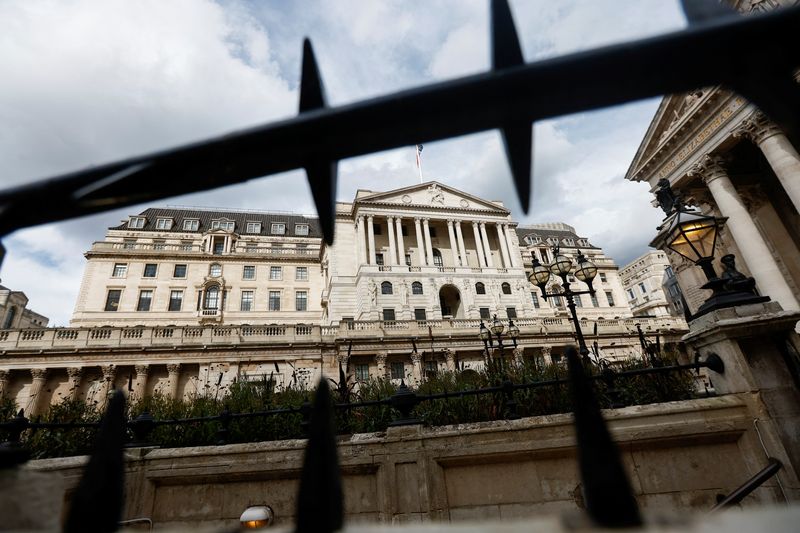
© Reuters. A general view shows the Bank of England in London, Britain, September 21, 2023. REUTERS/Peter Nicholls/File Photo
By Huw Jones and William Schomberg
LONDON (Reuters) -British businesses and households are coping with the climb in interest rates so far but the process of adjustment is far from over and banks must also prepare for changes to the way they fund themselves, the Bank of England said.
The BoE said the overall risk environment was challenging in the face of China’s economic problems, the risk of broader conflict in the Middle East and high public debt levels.
There were also questions about the rise of artificial intelligence, the BoE said in its half-yearly Financial Stability Report.
“Rates are likely to need to remain at these levels for an extended period to bring inflation back to target on a sustained basis,” BoE Governor Andrew Bailey told reporters.
“The full effect of higher interest rates is yet to come through. Therefore we remain vigilant to financial stability risks that might arise.”
The BoE said stronger-than-expected wage and income growth since its last review in July had reduced some of the strain on households which have been hit by high inflation and rise in taxes as well as higher borrowing costs.
“Nevertheless, household finances remain stretched by increased living costs and higher interest rates, some of which has yet to be reflected in higher mortgage repayments,” the BoE’s Financial Policy Committee said.
Businesses had also been broadly resilient to higher rates and weak growth, “but the full impact of higher financing costs has not yet passed through to all borrowers,” it said.
The British central bank, worried about the long-lasting impact of last year’s surge in inflation, raised interest rates at 14 meetings in a row between December 2021 and August this year to a 15-year high of 5.25%, where they have sat since.
BoE officials acknowledge signs of a slowdown in the economy but say they are not thinking about cutting rates because of signs that inflation pressure will stay strong.
However, British financial markets have stepped up bets on an early rate cut by the BoE in the past couple of days, following a similar shift in expectations for the European Central Bank and U.S. Federal Reserve, and now see a first quarter-point cut in May or June next year.
HIGHER FINANCING COSTS
The BoE urged banks to plan ahead for potential challenges in the way that they fund themselves, given a switch in deposits from normal current accounts to fixed-term, higher-interest savings which cost them more.
“The UK banking system is well capitalised and has high levels of liquidity,” the BoE said, adding that net interest margins have probably peaked but profitability was expected to remain robust.
However, the run on U.S. lender Silicon Valley Bank this year highlighted how lenders could be hit with sudden surges in withdrawals and the prospect of digital currencies also had implications for the stability of deposits at lenders.
Risks flagged by the BoE included upheaval in China’s real estate market which could worsen, and tensions in the Middle East which could push up oil prices and hurt economic growth.
It also reiterated its concern that high public debt levels in major economies could hurt Britain’s financial stability if markets turned more fearful about government bonds.
Outflows from funds invested in risky corporate debt and increased short and long positioning by hedge funds and asset managers in U.S. Treasuries could fuel further market volatility, the BoE said.
The central bank said it would monitor in 2024 the risks posed by the rise of artificial intelligence.
Deputy Governor Sam Woods said the BoE was looking closely at the growing use of AI by financial firms.
While specific regulations that target AI may not be the best way forward, financial firms using it had to understand properly what they were doing.
The BoE said that among corporate borrowers, firms in wholesale trade, real estate and construction and those which were energy-intensive faced higher risks than their peers.
As for households with mortgages, higher borrowing costs had impacted just over half of borrowers and the share of income spent on mortgage servicing was due to climb from 6.8% earlier this year to almost 9% by late 2026, although that would be lower than after past financial shocks.
Source: Investing.com



























